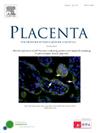SARS-CoV-2 infection disrupts syncytial and endothelial integrity and alters PlGF levels in the placenta
IF 2.5
2区 医学
Q2 DEVELOPMENTAL BIOLOGY
引用次数: 0
Abstract
Introduction
SARS-CoV-2 infection during pregnancy has been associated with an increased risk for several pregnancy-related disorders, particularly preeclampsia (PE). However, there are limited studies determining the impact of SARS-CoV-2 on placental physiology and function.
Methods
Placental samples were acquired from two large prospective cohorts: STOP-COVID19 and REBRACO studies. Placental villous tissues (VT) were collected from pregnant women who tested positive for SARS-CoV-2 without PE during pregnancy. Immunohistochemistry and immunofluorescence were used to assess pathological features known to be altered in PE, including 1) syncytial knot formation; 2) alterations in renin-angiotensin system components; 3) and endothelial integrity. Maternal serum was collected to examine AT1 autoantibodies levels using an immunoassay.
Results
SARS-CoV-2 viral proteins spike, nucleocapsid, and ORF3a were observed in the syncytiotrophoblast layer and stroma of placental VT. SARS-CoV-2-infected placentas exhibited increased numbers of syncytial knots, which were positive for Flt-1 and SARS-CoV-2 viral proteins. In addition, the presence of placental infarctions and excessive fibrin deposits was also observed in infected placentas. Infection was associated with decreased placental expression of PlGF and an increase in the placental Flt-1/PlGF expression ratio, mostly driven by PlGF. No significant changes in maternal serum AT1AA levels were observed. Finally, SARS-CoV-2-infected placentas exhibited a significant decrease in vimentin expression.
Discussion
SARS-CoV-2 infection negatively impacts placental integrity in the form of increased syncytial knots, dysregulated RAS components, and endothelial damage. Since all these features are similarly disrupted in PE, this could be a mechanism through which SARS-CoV-2 infection during pregnancy increases the risk of a PE-like syndrome.
SARS-CoV-2感染破坏合胞体和内皮细胞的完整性,并改变胎盘中PlGF的水平。
妊娠期感染SARS-CoV-2与几种妊娠相关疾病,特别是子痫前期(PE)的风险增加有关。然而,关于SARS-CoV-2对胎盘生理和功能影响的研究有限。方法:胎盘样本来自两个大型前瞻性队列:stop - covid - 19研究和REBRACO研究。从妊娠期间无PE的SARS-CoV-2检测阳性的孕妇收集胎盘绒毛组织(VT)。免疫组织化学和免疫荧光技术用于评估已知PE改变的病理特征,包括1)合胞结形成;2)肾素-血管紧张素系统成分的改变;3)内皮完整性。收集母体血清,用免疫分析法检测AT1自身抗体水平。结果:在胎盘VT合胞滋养细胞层和间质中观察到SARS-CoV-2病毒蛋白刺突、核衣壳和ORF3a,感染SARS-CoV-2的胎盘合胞结数增加,Flt-1和SARS-CoV-2病毒蛋白阳性。此外,在感染的胎盘中也观察到胎盘梗死和过量纤维蛋白沉积的存在。感染与胎盘PlGF表达降低和胎盘Flt-1/PlGF表达比升高相关,主要由PlGF驱动。母体血清AT1AA水平未见明显变化。最后,sars - cov -2感染的胎盘表现出明显的波形蛋白表达降低。讨论:SARS-CoV-2感染以合胞结增加、RAS成分失调和内皮损伤的形式对胎盘完整性产生负面影响。由于所有这些特征在PE中都类似地被破坏,这可能是怀孕期间SARS-CoV-2感染增加PE样综合征风险的机制。
本文章由计算机程序翻译,如有差异,请以英文原文为准。
求助全文
约1分钟内获得全文
求助全文
来源期刊

Placenta
医学-发育生物学
CiteScore
6.30
自引率
10.50%
发文量
391
审稿时长
78 days
期刊介绍:
Placenta publishes high-quality original articles and invited topical reviews on all aspects of human and animal placentation, and the interactions between the mother, the placenta and fetal development. Topics covered include evolution, development, genetics and epigenetics, stem cells, metabolism, transport, immunology, pathology, pharmacology, cell and molecular biology, and developmental programming. The Editors welcome studies on implantation and the endometrium, comparative placentation, the uterine and umbilical circulations, the relationship between fetal and placental development, clinical aspects of altered placental development or function, the placental membranes, the influence of paternal factors on placental development or function, and the assessment of biomarkers of placental disorders.
 求助内容:
求助内容: 应助结果提醒方式:
应助结果提醒方式:


